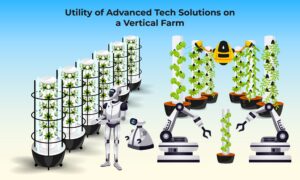The use of technology in agriculture is not a new concept. For years, farmers have been using technology to increase crop yields and improve livestock husbandry. However, with the advent of vertical farming, the use of technology has taken on a whole new meaning. Vertical farms are constructed vertically, with multiple levels stacked on top of each other. This allows for a much higher density of crops, as well as the ability to control the environment in which they are grown. This is done through the use of various sensors and computer-controlled systems that monitor and optimize conditions such as temperature, humidity, and light. While vertical farming is still in its early stages of development, it has already shown great promise. In terms of yield, vertical farms can produce up to 10 times more than traditional farmlands. They also use 90% less water and 50% less energy. Furthermore, because vertical farms can be built in urban areas, they can provide fresh produce to cities that would otherwise have to import it from elsewhere. There are many potential applications for vertical farming, and the use of advanced tech solutions will only make it more efficient and effective. If you\’re interested in learning more about vertical farming, be sure to check out.

Vertical Farming Technology
Vertical farming technology is an agricultural practice that involves growing crops in vertically stacked layers in a controlled environment. This type of farming allows for year-round production of crops, regardless of weather conditions, and can be done on a smaller footprint than traditional farming methods.
Vertical farms typically use less water and fewer chemicals than traditional farms and can be located closer to urban areas, which reduces transportation costs and carbon emissions. Additionally, vertical farming can help to reduce food waste by providing a consistent supply of fresh produce.
With the global population projected to reach 9 billion by 2050, there is a need for more efficient and sustainable methods of food production. Vertical farming technology offers a potential solution to this challenge, and its utility is only expected to grow in the coming years.
Automation and robotics
Vertical farming is an agricultural practice that involves growing crops in vertically stacked layers in a controlled environment. This type of farming has several benefits over traditional farming methods, including increased crop yields, reduced water usage, and decreased pesticide and herbicide use. One of the key advantages of vertical farming is the ability to control the environment in which the plants are grown. This allows for precision agriculture, in which specific conditions can be tailored to optimize plant growth.
Automation and robotics are two technologies that can be used to improve the efficiency of vertical farms. Automation can be used to control environmental factors such as temperature, humidity, and light intensity. Robotics can be used for tasks such as planting, harvesting, and sorting crops. By using these technologies, vertical farmers can increase crop yields while reducing labor costs.
IoT
The internet of things, or IoT, is a system of interconnected devices and sensors that collect and share data. IoT can be used in vertical farming to monitor conditions such as temperature, humidity, and light intensity. This data can be used to optimize growing conditions and improve yields. IoT can also be used to track inventory and automatically order supplies when needed.
AI & ML
The deployment of artificial intelligence (AI) and machine learning (ML) in vertical farming is providing farmers with the ability to optimize plant growth, improve yield, and decrease costs.
Through the use of sensors and data analytics, AI and ML can help farmers to understand the specific needs of each plant and make real-time decisions on when to water, how much light to provide, and what nutrients are needed. This level of precision not only results in healthier plants but also reduces water and energy consumption.
In addition, AI and ML can be used to automatically identify pests and diseases, allowing for early detection and treatment. This can help to reduce crop loss and ensure that crops are of the highest quality.
Overall, the use of AI and ML on vertical farms provides many benefits that can help farmers to improve yields, reduce costs, and produce healthy crops.
Future of Vertical Farming
The future of vertical farming is very exciting. With the advances in technology, we are able to grow more food in smaller spaces with less water and fertilizer. We are also able to control the environment better, which means that we can grow food all year round without worrying about the weather.
In the future, vertical farms will become even more efficient and productive. They will be able to grow a wider variety of crops and use even less water and fertilizer. The technology will also allow us to control the environment even better, making it possible to grow food in any climate.
The future of vertical farming is very bright. With continued advances in technology, we will be able to feed more people with less land and resources.